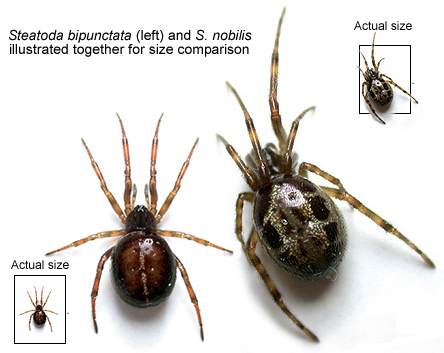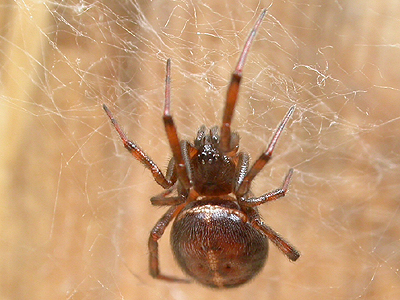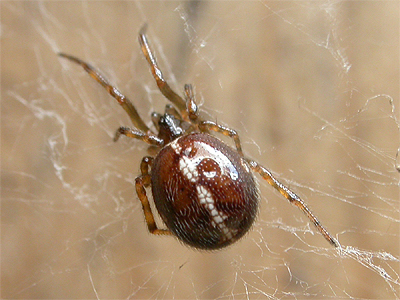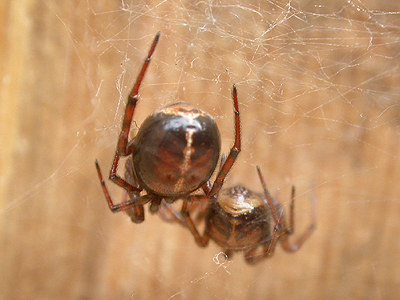

| The Rabbit Hutch Spider - Steatoda bipunctata | ||
| ...... |
| This harmless and extremely common
spider, has lived largely undetected and in close
proximity to humans and their pets for many centuries,
that most people never gave it a second thought when they
saw it. Then again they never had need to, but today,
things are perhaps a little different, even though the
Rabbit Hutch Spider (Steatoda
bipunctata) is completely
harmless. Being one of several spiders media sources love to label 'False Widows', the humble Rabbit Hutch Spider is now synonymously linked by a large proportion of the British public to the Noble False Widow (Steatoda nobilis). Incorrect and sensationalist media reporting, coupled with the lack of interest in undertaking some research of their own, has done Steatoda bipunctata, Steatoda nobilis and a few other spiders no favours. And to be honest, neither has the grossly exaggerated over-reaction of a proportion of the general public. |
 |
|
| ...... | ||
| Problems
with misidentification with Steatoda
nobilis Worse still, like several other harmless spiders found in or around our houses and outbuildings, Steatoda bipunctata is now very often the subject of misidentifications and uneccessary killing. These on-going repercussions are a result of the media's obsession with the Noble False Widow's northward spread across central counties of the UK. The media's over-reaction to the 'False Widow' aspect of the name, really has made life needlessly difficult for both these spiders and its not at all necessary. |
||
| ...... |
 |
In the past couple of
years, we've wrote a great deal about Steatoda
nobilis, following Nottinghamshire's first record
which was discovered under an interpretation panel at the
Nottinghamshire Wildlife Trust's Attenborough Nature
Reserve, by assistant reserve manager Tim Sexton during a
public Bat walk on September 17th 2016. Steatoda bipunctata's common name of the Rabbit Hutch Spider, is derived from its habit of choosing the dark corners of rabbit hutches to spin its untidy scaffold web. It is widespread across the whole of the UK and throughout Nottinghamshire, although the lack of interest in our Arachnid fauna, does mean that it is considerably under-recorded. Steatoda bipunctata is not a regularly seen spider and largely only active at night. It favours the quiet corners of sheds, out-buildings and cracks along fences and walls etc, where it constructs a typically unobtrusive 'scaffold' web. It is often found in hutches and poultry sheds, from where it derives its name of the Rabbit Hutch Spider. |
|
| ...... | ||
| Identification
of Steatoda bipunctata At first glance, the two spiders are very similar and difficult to tell apart. Look closer and there are features and markings that will help determine what spider is in front of you. Steatoda bipunctata is smaller and less sturdily built than Steatoda nobilis. The most obvious identifying feature is the attractive, rich chestnut brown coloured abdomen. This usually has a distinct a whitish line or band running dorsally across its length and a white line/band running around it laterally - although this can be harder to discern, depending on viewing angle. |
||
| ...... | ||
 |
 |
|
| ...... | ||
| Above left:- Dorsal view of adult female Steaoda bipunctata, showing typical abdominal markings and colouration. Photographed in a wooden coal bunker at Market Warsop April 2010. | Above right:- Rear dorsal view of adult male Steaoda bipunctata (smaller individual on the right) and same female as shown above left. Photographed in a wooden coal bunker at Market Warsop March 2011. | |
| ...... | ||
| The strength and clarity of the abdominal
markings can vary with the age of the individual spider,
and some older specimens can appear almost unmarked and
very dark. The legs are annulated (continuing
light/dark/light patterning etc) in both Steatoda bipunctata and
Steatoda nobilis. Leg annulation is usually a more
conspicuous feature in younger individuals. Please remember that no spider found naturally in the UK will kill you and that the vast majority of reported spider bites in both the national and local press are incorrect. Very few of our native spiders have jaws that can even pierce human skin. There is no need to kill any UK spider. |